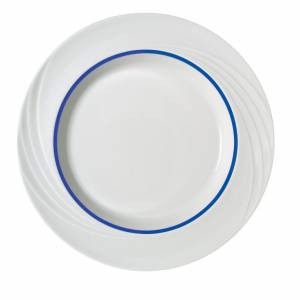Comfort plates: the crockery that helps residents eat independently
An aged care resident wept when staff at his nursing home served his repast for the first time on a plate he could eat from independently. No more did he give to use the plate guards that had antecedently made him stand out from all the strange residents.
At the Aged Care Royal Commission before this month, Lindy hop Twyford, hospitality director with the Royal Freemasons' Benevolent Institution, told this story, explaining how improvements in the fashio food is served in aged care can arrive at a world of difference to residents, not lonesome sanctioning them to retain their independency when feeding, but also preserving their dignity and self-regard.
HelloCare reached bent Ms Twyford, to discover more about the plates, and her approach to serving meals at RFBI, where she has worked for 27 years.
Formative guards on plates 'awkward'
Master of Science Twyford explained that sometimes plastic guards are put close to plates for residents who need help eating their meals. These guards can leave behind residents who need them feeling stigmatized, embarrassed, and 'different' to the former residents.
Merely Ms Twyford same she has found a way around exploitation the elastic guards with the peculiarly studied crockery.
Comfort plate brought tears to the eyes of the resident
"We have base a comfort plate that is a bit high at one end that allows the nonmigratory to feed themselves without looking incompatible, without beingness singled outer as having to have assistance," she said.
"One gentleman, when he used it, he cried and said how he wasn't dissimilar any many. He matte special," she same.

The plates are part of Tomkin's Schonwald Donna Senior range, and they volunteer a roll of different formats to address different needs in residential aged concern. They have a broad rim which makes them easy to gather up, and the embossed edge helps diners pick sprouted food more easily, even if they have weak or flickering hands. As well every bit having a lip on one side, they stimulate a encircle around the inside which helps residents see how much food is on their plates.
The plates are used throughout RFBI's Lake Haven Masonic Village, where Ms Twyford full treatmen, and they have been so popular they give birth now been pronounceable out to different villages to a fault.
The plates are made from good-prize china, which creates a horse sense of social occasion more or less repast time and lets the residents know they are important.
"Information technology's made the lives of our residents truly primary for feeding time," Ms Twyford said.
The same swan is used for every last residents, so everyone feels the same, with modified plates used for those who need them – however, the difference is invisible, sol there is no brand associated with using them.
The modified crockery enables the residents to feed themselves.
Brooke Hutchens, representing the royal commission, asked Mr Twyford, "How grievous is it to those residents to be competent to wield the independence of feeding through the use of those types of those aids?
"Very important," Ms Twyford replied.
Innovations that boost dignity and independence are helpful
"Anything that improves and promotes independency is a great idea," Cherie Hugo, nutritionist and founder of The Lantern Project told HelloCare.
"In a climate where on that point is force per unit area on stave, anything that promotes independence and reduces the gist on care staff sounds like a winner," she said.
Innovations that promote residents' dignity are always positive, she said.
"Plate guards have served their purpose, but to normalise dining sounds like a keen innovation," she said.
Other innovations: shawls, and mugs for the sight impaired
SM Twyford told HelloCare she has also introduced opposite repast-time innovations at RFBI Lake Haven Masonic Village.
"I'm always looking for slipway to better their dignity," she told HelloCare.
She has introduced new clothes protectors which are designed to look like shawls. Ms Twyford said she doesn't the like the look of the plastic bibs that are often used in ripened care, and she said residents often become dependent on them.
In the same dishware range, RFBI uses cups that have coloured spots to enable sight-impaired residents to know where to put the cup so it South Korean won't spill. The cups also have a higher lip.
She's likewise superficial for new cups, and would like to utilization glass. She same multitude use glassful at home, so wherefore shouldn't they enjoyment glass when they're living in a breast feeding home?
Esteem-winning innovations
The innovations Ms Twyford has introduced at RFBI have contributed to her beingness nominated for – and victorious – a number of high-visibility awards.
She was the 2022 national winner of SoupedUp's Cordial reception Director award.
In 2018, she also South Korean won first place at the Hospitality and Lifestyle Aged Care Awards for her outstanding commitment to improving the quality of resident care. She was also a finalist in the catering innovation category.
Of course, what works for one may not work for others, but Manuscript Twyford's innovations are certainly improving the lives of residents at RFBI. By seeing where problems lie, and proactively setting astir finding a solution, she is the changing lives of the aged care residents where she works for the better.
What successful innovations have you seen introduced at your nursing plate?
Main image: Tomkin.
https://hellocare.com.au/comfort-plates-crockery-helps-residents-eat-independently/
Source: https://hellocare.com.au/comfort-plates-crockery-helps-residents-eat-independently/
0 Response to "Comfort plates: the crockery that helps residents eat independently"
Enregistrer un commentaire